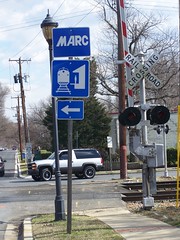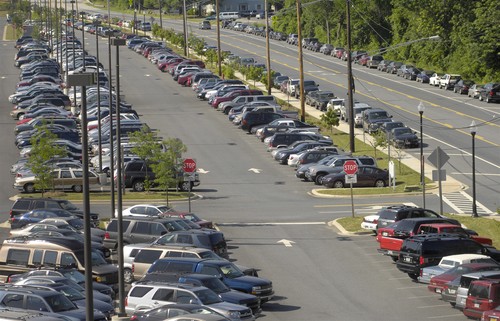The cost of a MARC train and other issues

Every so often, MARC (Maryland Rail Commuter) executives set up tables at places like Penn Station in Baltimore and Union Station in DC and open it up for dialogue with customers. I had been meaning to write to them about a bunch of issues, and yesterday (nice since I caught the right and fast bus and had an extra 20 minutes to kill) they were set up at Penn Station, so I talked to them about:
- no recycling bins at Penn Station (really this is Amtrak's problem)
- no recycling bins at Union Station in the train area (Amtrak's problem + the management of Union Station)
- the disgusting pro-smoking area immediately adjacent to the entry at Penn Station so that often you have to walk through a gauntlet of heavy smoking to get into the station (Amtrak's problem because they own and manage Penn Station)
- that Amtrak ought to be more responsive to MARC and MARC riders on these points (MARC and riders as Amtrak customers) since they lost the contract to provide service to VRE ("Va. commuter rail operation rejects
(- note that there is dedicated bicycle parking in the parking garage at Penn Station, but there isn't in the parking garage--not managed or owned by Amtrak--at Union Station. Although yes, there is the Bikestation.)
- since MARC cancelled their 10pm hour departure from Baltimore to DC, if I have to work late I am screwed (I need to sign up forGuaranteed Ride Home from Commuter Connections so that they have to pay for me to come back to DC after MARC's last train, mostly I just pay a premium to ride on Amtrak, but I could probably take a Zipcar overnight from Towson U or take the light rail to BWI and take the WMATA B30 bus to Greenbelt, or I could crash at a friends place in Baltimore...), I asked if they could work it out with Amtrak that MARC monthly and weekly ticket holders could ride between Baltimore and DC on at least one of the trains that stops in Baltimore between 9:30 and 11pm.
On the last point, I was told that it costs MARC just as much to pay for privileges to have riders on Amtrak trains as it does to run a train.
The rough metric is that it costs one train $1 million annually to run between Baltimore/Perryville and DC and back (one round trip). The cost works out to be $2,000 for each leg or $4,000/round trip, for 250 days of service.
... and that the late train from Baltimore was cancelled only because of budget problems and that if the budget ever improves, they intend to restore train service at this hour.
This makes sense as the MARC Growth and Investment Plan is about expansion, not contraction.
Some other parts of the conversation:
- He said that the charges from Amtrak are high, but then it's costly to maintain the Northeast Corridor, buy electricity, etc.
- That maybe it would be cheaper if the various states would go in together and buy the Northeast Corridor from Amtrak.
- I said we can't even get Maryland and Virginia to create one combined railroad service (which I call RACER, for Railroad Authority of the Chesapeake Region, see "Regional transportation planning and fixed rail service" and the original piece, "A regional railroad passenger transportation vision for DC, MD, VA, WV and parts of PA") so how soon could we expect that?

BeyondDC's sketching of opportunities for a regional railroad system.
- He thought that a combined service on the part of Maryland and Virginia (with a modicum of DC participation) is not out the question in our lifetimes. We didn't discuss the RACER ideas, which derive from ideas first laid out by Dan Malouff, which include connections to Pennsylvania and Delaware (although the latter is covered in the MARC Growth and Investment Plan), although I did mention the paper I wrote about this and I should probably send it to him. (Not that most of the ideas haven't already occurred to them.)

The commuter parking lot at the Halethorpe MARC station fills up fast in the morning. Commuters park on nearby streets, leading to clashes with residents. (Sun photo by Amy Davis / June 19, 2008).
- Finally, we talked about circulator type bus shuttle services to complement train service, to bring riders to stations without their having to drive, and without having to provide big parking lots.
Anne Arundel County is developing a circulator bus service to serve the Odenton train station as well as various facilities in that area, including Fort Meade and the NSA. These facilities get a lot of ridership from the DC region, which MARC likes because their service structure is "unbalanced" as 65% of their ridership is people going to DC from various points in Maryland.
MARC favors that idea, but probably doesn't have the money to help subsidize it. I mentioned the possibility of doing this at other stations. He said it really depends on what's around the station, if commercial facilities and/or government agencies were to locate at more stations (note the polycentric and sprawl aspects of this idea, even though it intensifies service possibilities and transit-centric mobility simultaneously)... that Halethorpe in Baltimore County isn't really a candidate for a circulator, because most of its riders get to the station using I-695 (the Baltimore Beltway) from various points in the region, that they don't live near the station, it's just convenient to use. So a circulator wouldn't get used and wouldn't reduce the need to provide parking there.
Labels: railroads, transit, transit economics



0 Comments:
Post a Comment
<< Home